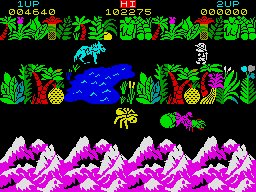Flip-screen

In video games, flip-screen (sometimes also known as flick-screen or page-flipping) is a principle whereby the playing environment is divided into single-screen portions (usually viewed from above, though sometimes from the side, or, more seldom, via an isometric view). Players see only one such screen at a time, and normally move to the next screen by having the player character/vehicle exit the current screen via one of the display's edges. At the point when the screen-to-next-screen move is performed, the picture abruptly "flips" to the next screen, hence the technique's name.[1][2]
History
While it appeared in some early arcade shooter games such as Space Dungeon, this mode of gameplay was much more common in 2D platform and maze games on 8-bit home computers and video game consoles during the 1980s. The flip-screen technique was particularly common in PC games originally made for the ZX Spectrum, such as Atic Atac, Jet Set Willy, and Starquake, due in part to the Spectrum's display limitations which meant that full colour scrolling was difficult to implement convincingly - Light Force being a notable exception. Monochrome scrolling instead was frequently seen in games, such as the early Penetrator, the later Bounder, and Gunfright.
These limitations were not exclusive to the Spectrum; many early MSX, NEC PC-8801 and PC VGA games also used the flip-screen technique. While it was possible to implement full-screen VGA scrolling, this required very precise programming and in many cases this meant sacrificing graphical detail. Examples of flip-screen PC games include the first two Prince of Persia games and Flashback. The flip-screen method was also used for early MSX computer games, including Vampire Killer and the stealth games Metal Gear and Metal Gear 2: Solid Snake. Examples of PC-8801 flip-screen games include Hydlide and Super Mario Bros. Special.
With the maturing of the graphics programming state-of-the-art on existing platforms, as well as the industry's move to more powerful third-generation consoles (beginning with the NES) and 16-bit computers, the flip-screen technique was gradually replaced by playing environments that scrolled, that is, those where the player remains in the centre of the screen while the environment "moves" past. Oddworld games on the original PlayStation are an exception.
There were also games that had some, but not all, of the earlier-mentioned aspects. The Legend of Zelda, for instance, also divides its environment into separate screen-sized sections (or rooms), as do the games in the same series made for the original Game Boy and Game Boy Color. However, instead of instantaneously flipping to a new screen when the player reached an edge, the transition between screens is achieved by rapid scrolling. A few games scroll normally within a small area but scroll rapidly to flip from area to area; these include The Legend of Zelda: A Link to the Past and the Nintendo 64 and Nintendo GameCube versions of Animal Crossing.
Mega Man also uses rapid scrolling to section-off mini-boss battles and major-boss battles, for example, mini-bosses found mid-level and the robot masters found after the gates at the end of the level. Typically the player cannot go back beyond the screen flip once it is traversed.
See also
References
- ↑ "Spindizzy review". Zzap!64. June 1986. Retrieved 25 February 2011.
- ↑ "Amaurote review". Crash. May 1987. Retrieved 25 February 2011.
External links
| Look up flip-screen in Wiktionary, the free dictionary. |